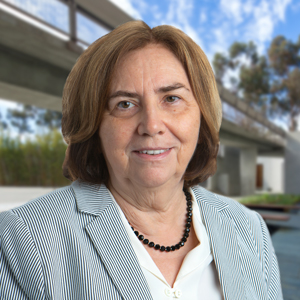Source: Interfolio F180

Elena Makarenkova, PhD
Research Focus
Muscle development and regeneration
Skeletal muscle atrophy is a devastating disorder that occurs in a large number of chronic diseases such as cancer, diabetes, trauma, cystic fibrosis, HIV, aging and genetic disorders. Research in my laboratory focuses on the mechanisms of muscle regeneration and regulation of satellite cell (muscle progenitor cell) function.
Satellite cells are the resident stem cell of muscle: upon activation they give rise to a proliferating myoblast population that differentiates into myofibres. Recent progress in understanding the muscle regeneration process in complex degeneration models (rather than simple focal injury models) has suggested that disrupted signaling within the microenvironment is a driver of failed regeneration and fibrosis. Wnts play important roles in myogenic progression; however, excessive Wnt signaling is also associated with muscle pathology and muscle aging. Canonical Wnt signals are shown to induce differentiation of myoblasts in vitro and in vivo, although the precise mechanism of this remains unclear.
We have pioneered studies of homeobox factors Barx2 and Pax7 in Wnt-mediated myogenesis, as well as in negative-feedback to attenuate Wnt signalling. This study defines the mechanisms by which canonical Wnt induces myogenesis, the roles of Barx2 and Pax7 in mediating the effects of Wnt signals, and the roles of these factors in controlling Wnt feedback. Our research may help to identify drug or cell-based therapies to increase regeneration and reduce fibrosis.
Our goal is to develop the new strategies that can improve muscle repair.
Molecular mechanisms of lacrimal gland development and regeneration
The dry eye condition involves chronic lack of ocular surface lubrication; symptoms include inflammation, pain, and in severe cases, blindness. In humans, the lacrimal gland (LG) is the primary contributor to the aqueous layer of the tear film, and dry eye syndrome is typically due to LG malfunction or damage.
Our goal is to develop new therapies able to restore lacrimal gland function. We believe that such therapies could be based on determining factors and mechanisms involved in the regulation of gland morphogenesis and regeneration or on isolation and transplanting stem or progenitor cells. Our ongoing work seeks to identify cell progenitors able to restore the function of the 'diseased' lacrimal gland as a critical first step in the development of stem cell-based strategies to treat patients with dry eye conditions. We have recently shown that members of the (FGF) family are important regulators of lacrimal gland homeostasis, regeneration and stem cell function. If we succeed, it would drastically improve the quality of life of people affected by dry eye.
Our long-term goal is to develop therapeutic approaches for the regeneration of damaged human lacrimal gland.
Education
M.S. (Zoology and Developmental Biology), Leningrad State University, Russia, 1980
Ph.D. (Zoology and Cell Biology), Leningrad State University, Russia, 1989
B.S. (Zoology and Developmental Biology), Leningrad State University, 1979
Professional Experience
2012-present :Assistant Professor, Department of Cell and molecular Biology, The Scripps Research Institute, La Jolla, CA The Scripps Research Institute, La Jolla, CA
2008-2012: Assistant Professor, Department of Neurobiology, The Scripps Research Institute, La Jolla, CA The Scripps Research Institute, La Jolla, CA
2001-2012: Associate Fellow, The Neurosciences Institute, La Jolla, CA
1998-2001: Associate Research Scientist, Skirball Institute Developmental Genetics Program, NYU Medical Center, New York, NY
1996-1997: MRC Laboratory for Molecular and Cell Biology, University College, London
1994-1996: Wellcome Trust Fellow, Department of Anatomy and Developmental Biology, University College, London
1989-1994: Independent Research Scientist, Department of Physiology and Cell Structure, Institute of Cytology of Russian Academy of Sciences, St. Petersburg
1989: Ph.D. Zoology & Cell Biology, Leningrad State University
Awards & Professional Activities
1980 M.S. Thesis Award, Department of Zoology and Developmental Biology, Leningrad State University, Russia
1986 2nd Prize in Ph.D. student's research paper competition, Zoological Institute, Russian Academy of Science
1992 Soros Award, Paul & Daisy Soros Fellowships Award
1994 Soros Travel Award to participate in SPIE Conference, Paul & Daisy Soros Fellowships Award
1995 Wellcome Trust International Travel Fellowship,
2013 Mentor Certificate of Appreciation in MS Biotechnology & Bioinformatics, Stem Cell Research Internship Program
Selected Publications
Voronov, D.; Gromova, A.; Liu, D.; Zoukhri, D.; Medvinsky, A.; Meech, R.; Makarenkova, Helen Transcription factors Runx1 to 3 are expressed in the lacrimal gland epithelium and are involved in regulation of gland morphogenesis and regeneration. Investigative Ophthalmology and Visual Science 2013, 54, 3115-3125.
[View]
Meech, R.; Gonzalez, K. N.; Barro, M.; Gromova, A.; Zhuang, L. Z.; Hulin, J. A.; Makarenkova, Helen Barx2 is expressed in satellite cells and is required for normal muscle growth and regeneration. Stem Cells 2012, 30, 253-265.
[View]
Zhuang, L.; Hulin, J. A.; Gromova, A.; Nguyen, T. D.; Yu, R. T.; Liddle, C.; Downes, M.; Evans, R. M.; Makarenkova, Helen; Meech, R. Barx2 and Pax7 have antagonistic functions in regulation of wnt signaling and satellite cell differentiation. Stem Cells 2014, 32, 1661-1673.
[View]
Makarenkova, Helen; Hoffman, M. P.; Beenken, A.; Eliseenkova, A. V.; Meech, R.; Tsau, C.; Patel, V. N.; Lang, R. A.; Mohammadi, M. Differential interactions of FGFs with heparan sulfate control gradient formation and branching morphogenesis. Science Signaling 2009, 2, ra55.
[View]
Tsau, C.; Ito, M.; Gromova, A.; Hoffman, M. P.; Meech, R.; Makarenkova, Helen Barx2 and Fgf10 regulate ocular glands branching morphogenesis by controlling extracellular matrix remodeling. Development 2011, 138, 3307-3317.
[View]
Makarenkova, Helen; Shestopalov, V. I. The role of pannexin hemichannels in inflammation and regeneration. Frontiers in Physiology 2014, 5.
[View]

